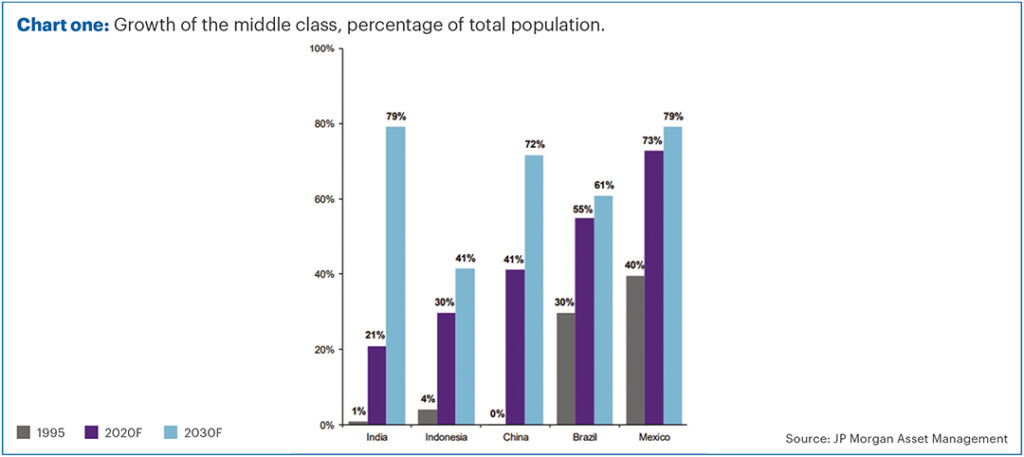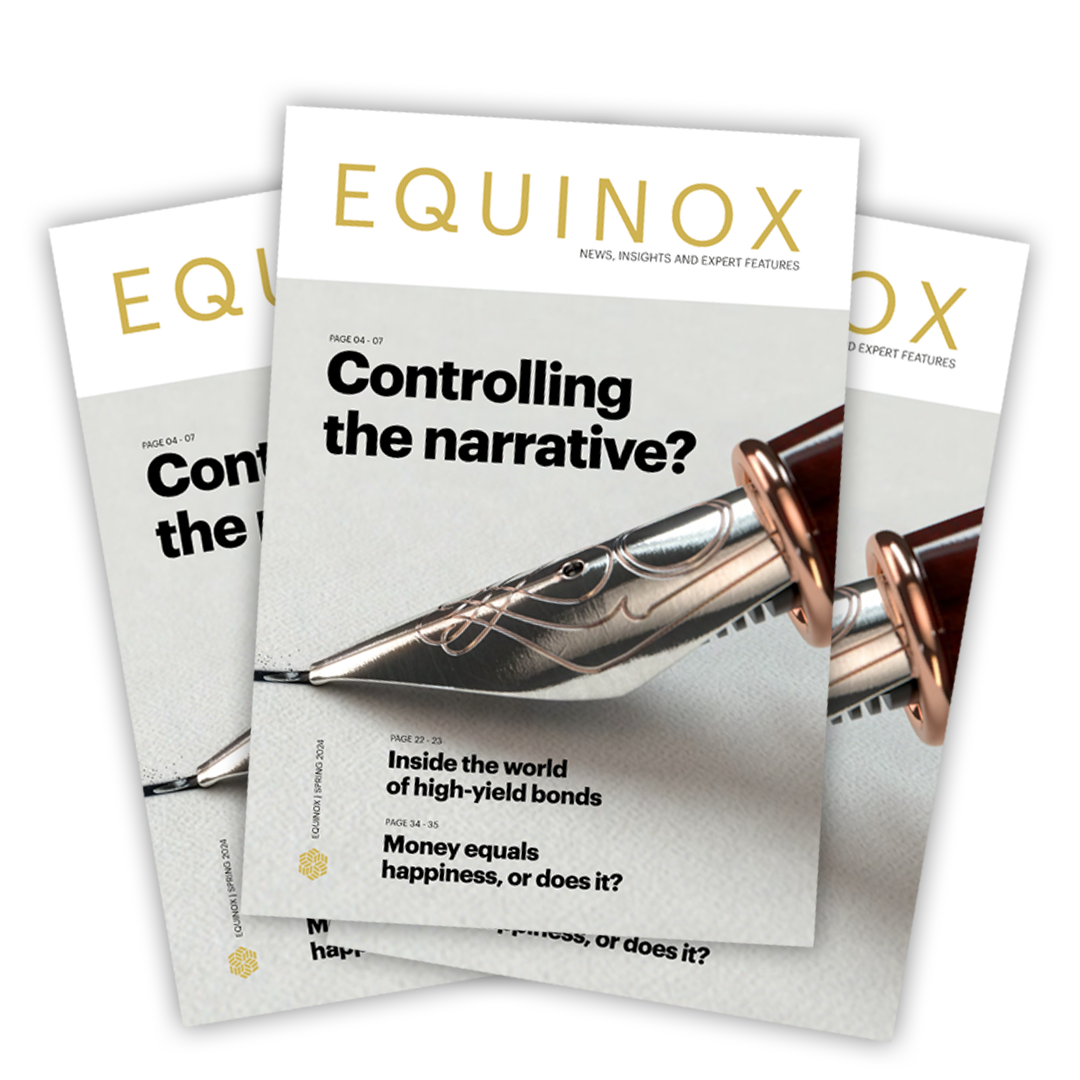Building for the future
We are often asked for our thoughts on where markets are likely to go over the next few weeks and months.
We’ll always tell you our views and we certainly won’t duck the question! However, we’ll also be clear that trying to predict what will happen over relatively short time periods is a mug’s game. Over the short term, market movements are all about changes in sentiment. We call this “noise”!
It is more unusual for us to be asked about long-term trends, but of course investing should be for the long term.
Unlike most things in life, when it comes to investing, we think that the long term is often more predictable than the short term! Various valuation metrics have historically given us a good idea of the likely returns over the next five or 10 years, for example.
Of course, the valuation is only part of the picture. The other part is much more
difficult – trying to work out how the world might change over the next decade!
However, there are certain themes that we can say with relative confidence will be important to investors over the next few years. The uncertain bit is how to “play” such themes.
Here are a few of the themes we think might be important for the next 10 years or so.
Ageing populations
This is one of the most predictable trends. Everyone gets older whether they like it or not!
More importantly, given we know the “shape” of population pyramids now, we can tell with a reasonable deal of certainty what shape it will be in 10 years’ time. The proportion of retired people to workers is shifting and this will have implications for economic growth in general.
West to East
At current rates of economic growth, China will overtake the US to become the world’s biggest economy at some point in the next decade.
People in emerging markets as a whole, but particularly in Asia, are becoming wealthier, which means they have more money to spend. Chart one shows what proportion of various countries is considered “middle class” and how this is expected to change between now and 2030.

The consumer is becoming a much more important driver of emerging market economies and this is likely to substantially increase. Companies that sell to Asian consumers, such as luxury goods and technology firms, have a favourable wind behind them.
India stands out as seeing a particularly big increase in its middle class. It also is one of the few major economies that has more favourable demographics and an increasing
– rather than shrinking – working age population.
We think having a decent sized exposure to Asia makes a lot of sense.
Climate change
Environmental, social and governance (ESG) factors are now being seen as an increasingly important part of investing.
Not only is taking such things into account the right thing to do, we also believe it is 100% necessary.
Climate change in particular will give many companies a real challenge, particularly those responsible for high CO2 or equivalent emissions, who may face regulation or tax. Companies that cannot adapt are unlikely to be great investments.
However, there are also companies who may benefit as well. This might include renewable energy providers, electric vehicle manufacturers or other technology firms who can help us adapt.
We also think that carbon offsetting and the trading of carbon credits may become more mainstream.
Government spending and debt
Governments around the world are attempting to spend their way out of the pandemic.
In particular, the Biden administration in the US is launching a huge infrastructure program. Similar promises, if not actual policies, are being made on this side of the Atlantic too.
The flip side of this is that governments will end up with very high levels of debt. If they can, they’d like to generate a bit of inflation to reduce this debt in real terms. Because of the demographic trends, we think this might be difficult, but the right spending on the right project might help in this regard.
Central banks are targeted to keep inflation under control. Even a small amount of persistent inflation will mean interest rate hikes. We don’t think these will be massive, but any increase in rates would not be great for fixed interest bonds.
Mark Twain once said: “buy land, they’re not making it anymore.”
Perhaps Twain would agree that, in the modern world, the way to respond to this is by owning not just land but other “real assets”.
Not exciting, digital (pretend?) assets like Bitcoin (don’t get me started) or NFTs (if you don’t know, you don’t want to know). Real, boring, physical things.
Infrastructure is an obvious potential beneficiary of government spending, particularly where it also benefits from spending to combat climate change such as renewable energy. Land and forestry might also benefit from attempts to offset carbon.
Certain types of property may benefit too. Again, it helps if they are also linked to one of the other themes, so this might include the health care sector (care homes, GP surgeries), social housing, and distribution warehouses (benefiting from the move to online) might also be included.
Selling shovels…
In a gold rush, the people who get rich aren’t always the people who go searching for the gold. A few people might strike it lucky, but many of them take a load of risk and end up with nothing.
Often, the people who make the most money, most reliably, are the people who sell the shovels!
For all these themes, the way to play them is not always the obvious one. Often, it is the “enablers” who benefit equally as those searching for gold.
Many of themes outlined above are technology based. Given the demographic trends, if we want to keep our economies growing, we need to get more productive.
Examples of “enablers” include semiconductors – a key component of many electronics – where a global shortage has recently driven up prices. For those who sell their goods online, the payment processors (Visa, Mastercard, PayPal and many more) are vital to their businesses.
Sometimes we call this type of thing “digital infrastructure”. As an aside, some of these firms may benefit if crypto-currencies become more widespread – another example of selling shovels to those trying to mine (digital) gold!
We can never predict the future, but if there are any potential trends which might be a risk, or a benefit to investment portfolios, then we need to take them into account.
Factsheets
To see the long term strategic allocations for each of our funds, along with the latest monthly factsheets please click here.
These represent Equilibrium’s collective views and in no way constitutes a solicitation of investment advice. The value of your investments can fall as well as rise and are not guaranteed. Investors may not get back the amount originally invested. We usually recommend holding at least some funds in all asset classes at all times and adjusting weightings to reflect the above views. These are not personal recommendations, so please do not take action without speaking to your adviser.



